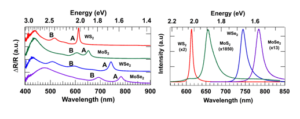Groundbreaking work in the electronic and optical properties of monolayer graphene flakes has recently stimulated the search for other atomically thin material systems with appealing physical properties. Of particular interest are monolayer materials that exhibit semiconducting and insulating behavior. Remarkably, it has been discovered that a large class of transition metal dichalcogenides (TMDCs), when reduced to a single layer, exhibit emergent photoluminescence as a result of quantum well-like quantum confinement. Particularly attractive is the large binding energy (~500 meV) exhibited by the excitons in these materials since this makes possible stable room temperature exciton formation. The below two figures demonstrate reflectivity (left panel) and photoluminescence (right panel) from single layers of each of the TMDCs.

The large exciton binding energies make these materials a natural platform for studying the many-body physics of excitons and charged exciton complexes. The two-dimensional nature of the materials, the availability of semiconductors, metals and insulators, and the possibility to assemble van der Waals heterostructures has resulted in numerous fundamental physics investigations as well as the demonstration of advanced optoelectronic and nanophotonic devices. In addition to the conventional physical characteristics of these materials, the electronic excitations also exhibit a robust valley degree of freedom that coherently interfaces with photon polarization and can potentially provide the physical basis of next-generation information processing applications
